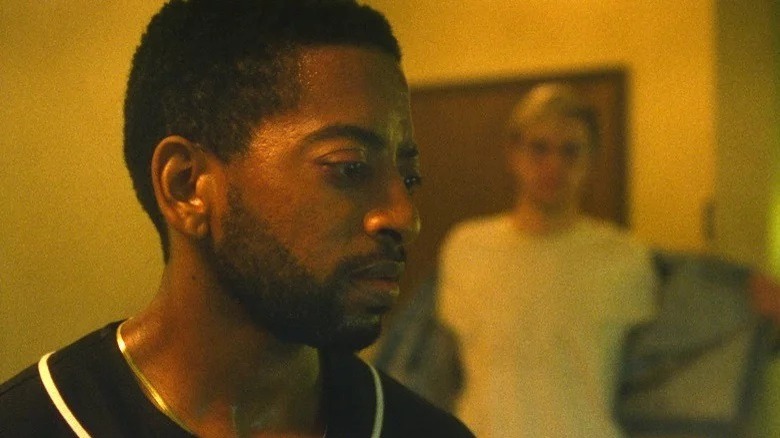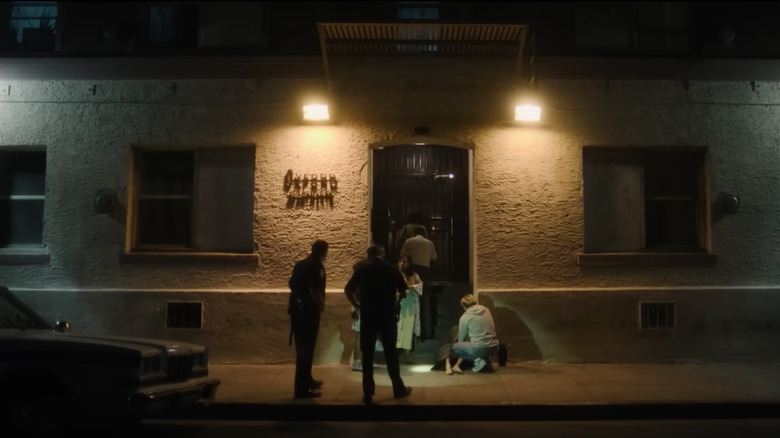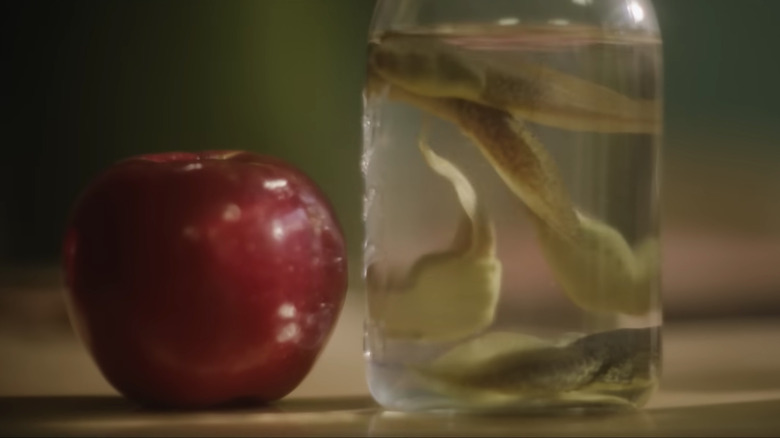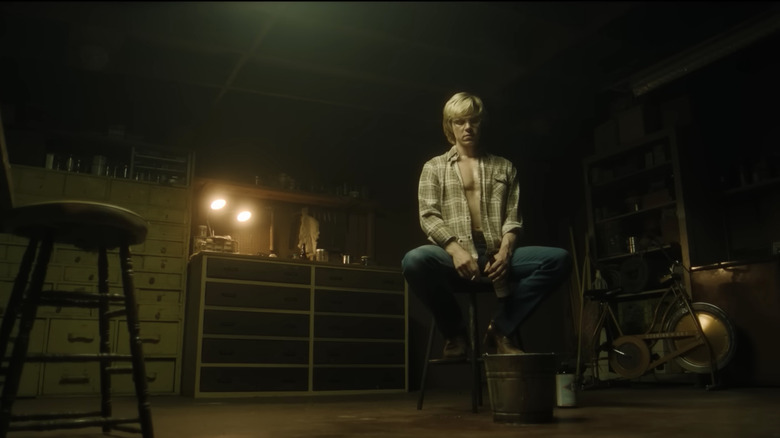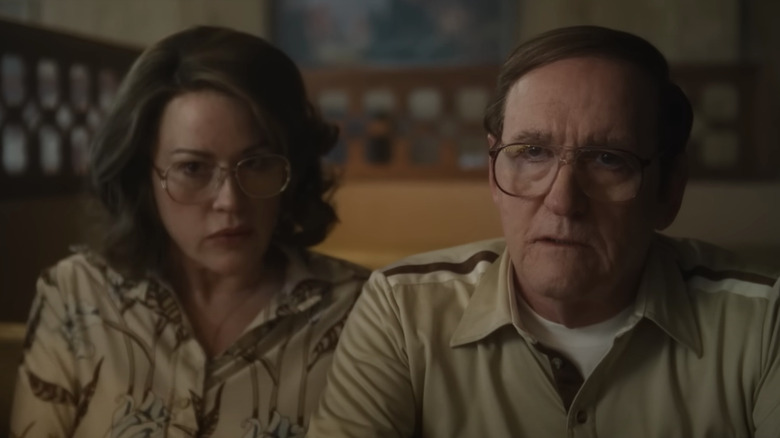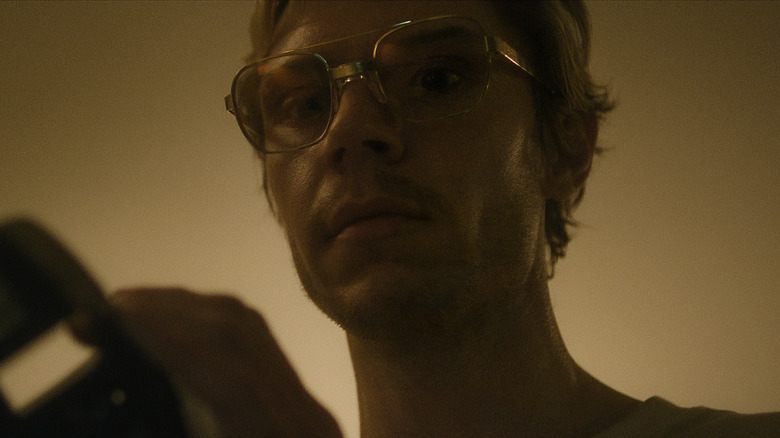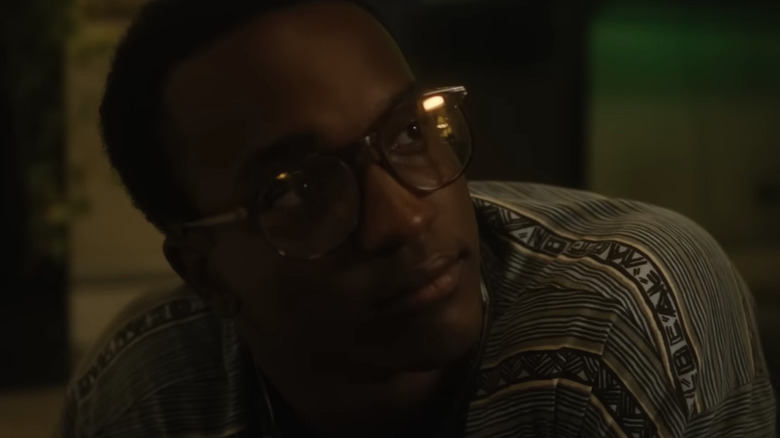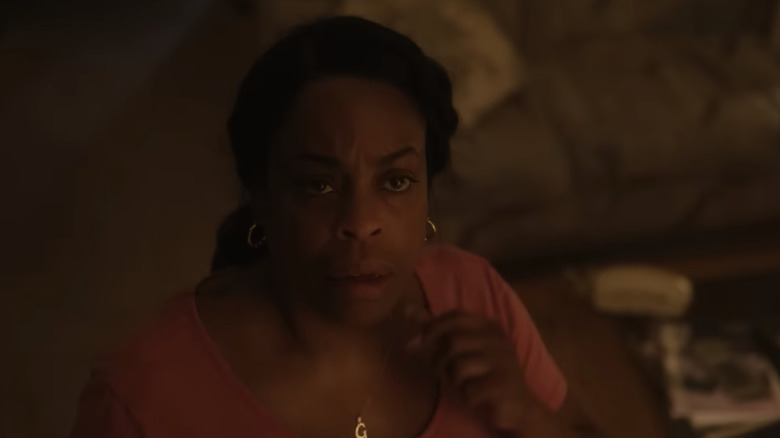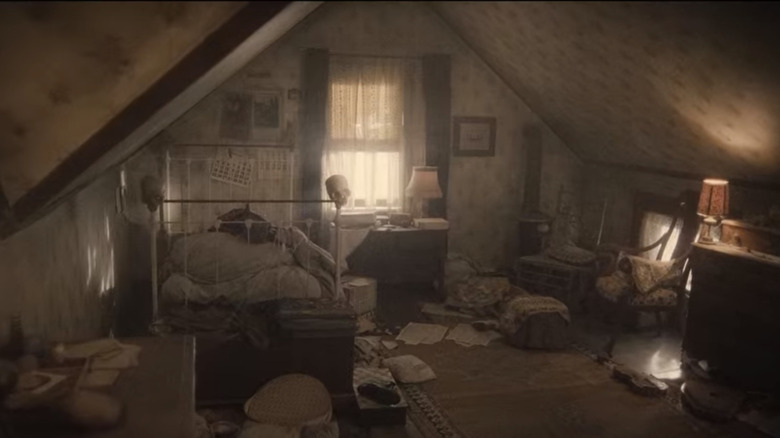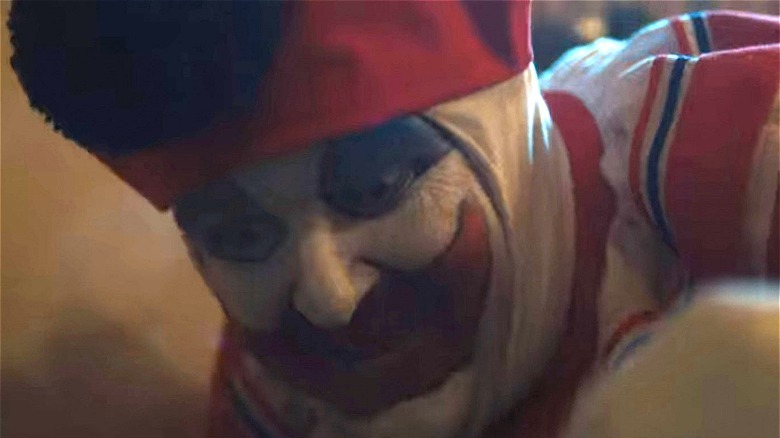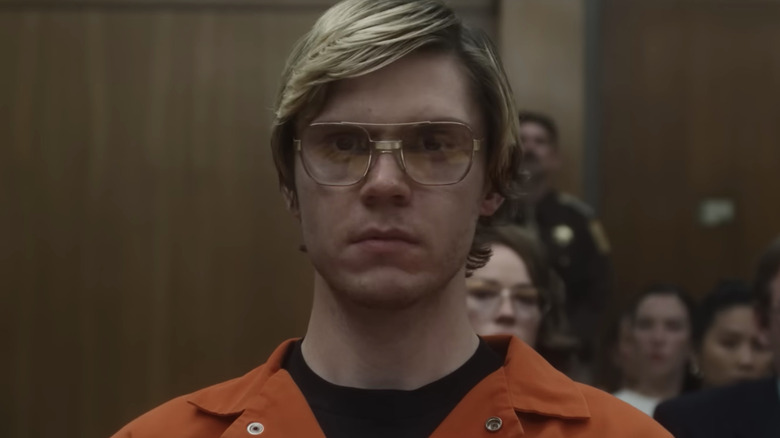14 Most Disturbing Moments From Monster: The Jeffrey Dahmer Story Ranked
This article contains mentions of sexual assault and extreme violence.
Ryan Murphy's terrifying depiction of Jeffrey Dahmer's monstrous acts captivated and thrilled a global audience in "Monster: The Jeffrey Dahmer Story." In fact, the Evan Peters-led dramatization is Netflix's most viewed series over a week-long period. This astonishing feat means it has surpassed streaming hits like "Squid Game," "Cobra Kai," and even "Stranger Things."
The series reunites Murphy with "American Horror Story" alum Peters as well as "Scream Queens" star Niecy Nash, who shines as Dahmer's inquisitive neighbor Glenda Cleveland. Dahmer's truly horrific acts are harrowingly illustrated in this true crime reenactment, which shines a light on "how society and our system failed to stop him multiple times because of racism and homophobia," Peters told Netflix's Queue.
We've known about Dahmner's sickening crimes for decades, but Murphy shows us his killing spree through the eyes of his victims rather than the killer himself, which makes his show all the more terrifying. These are the most disturbing moments from "Monster: The Jeffrey Dahmer Story," ranked.
Dahmer's bone chilling apartment
Episode 1 wastes no time introducing us to Dahmer's lair from hell. He lures an unsuspecting victim (Tracy Edwards, played by Shaun J. Brown) into his "The Exorcist III" viewing party, and his guest soon realizes that he's in grave danger. An unflinching pan over a bloody drill wordlessly conveys Dahmer's past carnage to the audience, and it's a warning to Tracy that he needs to get out as soon as possible.
As sickening as it is, it's impossible to turn away from "Monster: The Jeffrey Dahmer Story," and that's due in part to the show's commitment to realism. This authentic representation is present in other Ryan Murphy shows like "American Crime Story," but it's exceedingly prevalent in "Monster: The Jeffrey Dahmer Story." What makes the opening episode even more disturbing is that the police refuse to take Edwards seriously after he escapes from Dahmer's clutches.
Tragically, the officers that Tracy flags down accuse him of being on drugs and are reluctant to investigate this seemingly normal man's apartment. However, after they finally do, they find jaw-dropping, vomit-inducing evidence of murder and butchery. From here, we go back in time to find out how Dahmer became such a deplorable monster.
The grossest example of negligence
One of the most heartbreaking scenes in "Monster: The Jeffrey Dahmer Story" involves 14-year-old victim Konerak Sinthasomphone (Kieran Tamondong). In the show, Sinthasomphone manages to escape from Dahmer's apartment despite being drugged and severely injured. Bleeding and terrified, he goes to the police. However, when Dahmer shows up and tells the officers that Sinthasomphone is 19 years old and that the two are in a relationship, they believe the killer. Dahmer claims that Sinthasomphone has just had too much to drink when in reality he has a horrific brain injury inflicted by the serial killer. The police actually help Dahmer take the boy back to his apartment, not wanting to get involved in what they deem to be a spat between two gay men.
Shockingly, this scene plays out almost exactly how it happened in real life. The officers on duty at the time believed Dahmer, who would murder Sinthasomphone soon after. In "Monster: The Jeffrey Dahmer Story," Dahmer's abduction of Sinthasomphone occurs near a gas station with an eerie warning — a slow pan briefly shows a missing person poster stapled to a telephone pole with one of Dahmer's previous victims on display. This chilling clue is missed by Sinthasomphone, who unfortunately follows Dahmer home, desperate to make some money for his family.
Dahmer's earliest warning signs
As seen in the enthralling 10 episode Netflix series, Jeffrey Dahmer was a particularly disturbed child. He has a sick fascination with carving up and dissecting dead animals that goes far beyond scientific curiosity. One of the earliest indicators of Dahmer's questionable interests lies in an early warning sign foreshadowing his need for control.
A traditional gift for a teacher to show appreciation is typically a coffee mug or even more traditionally, an apple. It is, however, a very curious thing to give them a jar of writhing tadpoles desperate to escape. After his teacher re-gifts the odd present to an inquisitive young boy, Dahmer has an emotional outburst that leads him to steal back the tadpoles. He then punishes them by pouring motor oil directly in the jar and watches them squirm and suffer with a smiling face. The spine-chilling moment prefaces Dahmer's psychotic deeds and his cruel actions towards animals is even a scary red flag for his future psychopathy, per Psychology Today.
Dahmer's isolating slip into the void
Dahmer's cold detachment reached even more alarming levels when his mother left him while stealing his younger brother away from him. As if that weren't enough, she verbally degraded him before she left, leaving him in a dooming spiral of self-sabotage — not that any of that excuses his appalling crimes. This isolation tees him up to become the monster we see in Ryan Murphy's series.
Dahmer needs to find something to fill the void, and his twisted mind begins to turn towards violence. He begins fantasizing about the topless guy who jogs around his neighborhood until thinking isn't enough anymore. He grabs a baseball bat and patiently waits for him to come around the corner before leaping out, ready to swing, and... deciding not to go through with it. His hesitation doesn't last long, however — he takes his first victim soon after.
Dahmer's fantasies become reality
Dahmer's violent outburst isn't even the most unsettling element of his first murder. When he picks up an unsuspecting hitchhiker, he utilizes the chance encounter as an opportunity for friendship. However, when things don't go his way, he impulsively gives in to his dark desires and bashes Steven Hicks ("American Horror Story" veteran Cameron Cowperthwaite) in the head. When that doesn't kill him immediately, he strangles him to death, establishing Dahmer's sick pattern of intimate execution.
After the shock of what he's done wears off, he panics and hurriedly hides the body. He soon realizes that no one is coming for him, however, and begins to believe that he has gotten away with murder. Dahmer becomes giddy as he disposes of the body by flushing the remains down the toilet and shattering Hicks' bones with a hammer. He begins to develop a sense of invulnerability and one murder becomes many.
He tried to tell them
When Dahmer started killing, those closest to him began to notice a change. In Ryan Murphy's "Monster: The Jeffrey Dahmer Story," there's a moment in which it appears as though Dahmer is going to confide in his father and his dad's partner (played by perennial did-type Richard Jenkins and 1980s icon Molly Ringwald) about what's been going on, but they don't seem like they want to hear it.
The show makes it appear as though Lionel Dahmer is more concerned about the idea of his son coming out as homosexual than anything else. His new girlfriend Sheri is shown to be equally disinterred in digging too deeply, preferring to maintain the status quo and not rock the boat too much, fearful of what the truth about Jeffrey's life might mean for her and Lionel. The idea that numerous lives could have been saved had this conversation went another way is chilling.
An item worthy of his precious box
In "Monster: The Jeffrey Dahmer Story," the death of Steven Tuomi (played by Vince Hill-Bedford) is both a blur to Dahmer and the audience. The twisted killer wakes up next to Tuomi's beaten and bruised body before gruesomely dismembering him at his grandmother's house. This highlights Dahmer's disrespect for humanity and proclivity for evil (also underlined in his adoring repeated viewings of "The Exorcist III"), which only grows as he continues to avoid persecution.
In one of the show's most disturbing moments, he decides to keep Tuomi's head, tucking it away in a wooden box. In an extremely hard to watch moment, he kisses the severed head on the lips. In real life, Dahmer was never officially charged for Tuomi's murder due to a lack of evidence. "Dahmer did not recall details but believes he killed Tuomi at the Ambassador Hotel," USA Today reported. "Tuomi's father, Walter, said he was originally told by Milwaukee police that they could do nothing because there was no sign of foul play."
Another victim of Dahmer's deadly dosing
Ronald Flowers (played by Dyllón Burnside of Ryan Murphy's ballroom scene drama "Pose") is one of the victims that managed to escape from Dahmer with his life. Dahmer happened upon Flowers when he was having some car trouble and offered to give his vehicle a jump. He took Flowers back to his place under the pretense that they would return with his vehicle and jump-start Flowers' car, but that never happened — Dahmer gave Flowers some drugged coffee. "The last thing I saw was the floor and his shoes," he recalled in the 2020 documentary series "Jeffrey Dahmer: Mind of a Monster," adding that the last thing he remembered feeling was "sheer terror."
Dahmer didn't kill Flowers, but he sexually assaulted him. When he regained his senses, he naturally reported the incident to the police, who — as is shown in the Netflix drama — frustratingly brushed him and his accusations aside. It was yet another fatal blunder that led to more deaths. Due to the color of the accuser's skin and the sexual nature of the alleged crimes, Dahmer was often let go and allowed to continue his heinous actions.
If you or anyone you know has been a victim of sexual assault, help is available. Visit the Rape, Abuse & Incest National Network website or contact RAINN's National Helpline at 1-800-656-HOPE (4673).
A hair-raising round of Jeff's twisted board game
Episode 6, "Silenced," is a phenomenal episode starring Rodney Burford as Tony Hughes. The heart-wrenching episode centers on Hughes, a deaf Black man who fell prey to Dahmer while looking for friendship and partnership. Dahmer's ability to lure men home is a troubling quality that allowed him to take far too many innocent lives.
"Silenced" contains an odd moment of tension when Hughes and Dahmer play a homemade board game about a black void that swallows anything that doesn't conform to its way. Dahmer's game puts the audience in a state of unease as we await his next explosive outburst. Hughes uncovers a shocking amount of driver's licenses showing just how many lives Dahmer has snuffed out.
When Hughes questions Dahmer's rules, he snaps and retrieves a bloody hammer from his drawer, ready to put an end to it all. In the proceeding scene, Dahmer takes a sick pleasure in calling victims' families and letting them know their loved ones are now "in the void."
Sounds and smells
Niecy Nash's portrayal of Glenda Cleveland provides a necessary balance to Evan Peters' frightening turn as Jeffrey Dahmer. Her suspicions of his largely unmentionable exploits were absolutely founded and ended up being entirely true. She tried to alert police after seeing a victim flee from his apartment — in real life, she lived in an adjacent building, not in the same one, as is shown in the Netflix series.
In the show, Cleveland hears distressing sounds coming from Dahmer's apartment at all hours of the night. Her desperation and cries for help echo the audience, who become as frustrated as her when no authority figures take her pleas seriously. In one of her darkest moments, Cleveland pleads with a 911 operator to send a car about the noises of Dahmer strangling yet another victim.
They are reluctant to send services to her part of town (a recurring problem) and instead advise her to investigate herself. Nash is understandably flabbergasted and refuses the ridiculous suggestion, while adding a tiny moment of levity through her humorous inflections and facial expressions. She's a bright spark in a very dark show.
The haunting use of Ed Gein's House of Horrors
An unexpected element in "Monster: The Jeffrey Dahmer Story" is the use of other serial killers, including Ed Gein, the notorious murderer who inspired Alfred Hitchcock's classic horror film "Psycho" and Tobe Hooper's seminal slasher "The Texas Chainsaw Massacre." Like Dahmer, Gein's gruesome crimes gained worldwide attention. In the Netflix show, Dahmer's father and lawyer pull examples from Gein's case to help Dahmer in court — both had difficult childhoods and issues related to their relationships with their mothers.
Viewers are taken into Gein's so-called House of Horrors, where the body of hardware store owner Bernice Worden was discovered by police. She had been decapitated. The head of tavern operator Mary Hogan was also found on the property. The idea of Gein's case helping Dahmer get a lesser sentence in any way is a stomach-turning thought, but even as a standalone scene, the Gein house tour is enough to give you nightmares.
A horrifying parallel to Dahmer's crimes
Another real-life serial killer that is shown in "Monster: The Jeffrey Dahmer Story" is John Wayne Gacy, who killed 33 boys and young men in the 1970s. Longtime fans of Ryan Murphy's bone-chilling work will know that he's done Gacy on screen before. In fact, Dahmer and Gacy were both featured in Season 5 of "American Horror Story." In the episode "Devil's Night," the most infamous and evil beings gather for an unforgettable night of blood-soaked madness.
Gacy also inspired another alarming character in "American Horror Story," according to E! News: The deformed and towering Twisty the Clown, who slaughters his victims often without discretion, making him even more fearsome. In "Monster: The Jeffrey Dahmer Story," Murphy brings Gacy to life with his former "Feud" collaborator Dominic Burgess. The disturbing scene in question prompted viewers to tweet at the actor that they'd love to see him in a spin-off unraveling Gacy's murders as Murphy did with Dahmer.
The toll on his victims' families
"Monster: The Jeffrey Dahmer Story" attempted to paint a compelling viewpoint for the victims' families. Ryan Murphy wanted to refocus the narrative and draw the attention away from the prolific murderer, even if for just a moment. However, in most instances, the families were still distraught by what they saw as a glorification of violence and morbid intrigue. Several family members spoke out against the Netflix show, like Rita Isbell, who famously had an emotional outburst towards the unflinching monster in court. "It's sad that they're just making money off of this tragedy," she wrote in an Insider op-ed. "That's just greed."
The families' never-ending suffering was shown on screen in Episode 9 when Konerak Sinthasomphone's family was continually harassed over their private landline. We also see fan mail sent to Tony Hughes' mother's home in a stomach-turning scene where she imagines seeing Dahmer across the street like the "Halloween" slasher Michael Myers. These haunting and highly disturbing moments show the audience that the families will never be able to fully recover from Dahmer's despicable actions.
Dahmer's haunting legacy and enduring intrigue
One of the many reasons the families of Dahmer's victims can't rest peacefully is because we won't let them. Our perplexing preoccupation with serial killers and true crime documentaries appeals to our darker nature. The safe distance between our couch and television screens acts as a barrier that often leaves little room for empathy and too much room for detached entertainment.
The record-breaking consumption of "Monster: The Jeffrey Dahmer Story" says something about our global society. Yes, Dahmer is brutally (and poetically) murdered by a fellow inmate in the end, and that scratches a dark itch — we revel in his bloody demise. Fittingly, his brain ends up in a jar inside a refrigerator, like the head found in his apartment. However, following a division between his parents' wishes, Dahmer's brain was incinerated rather than studied. This eases our worries that the monster has been vanquished, allowing us to feel safe at night once again... at least until the next serial killer gets their own drama.

